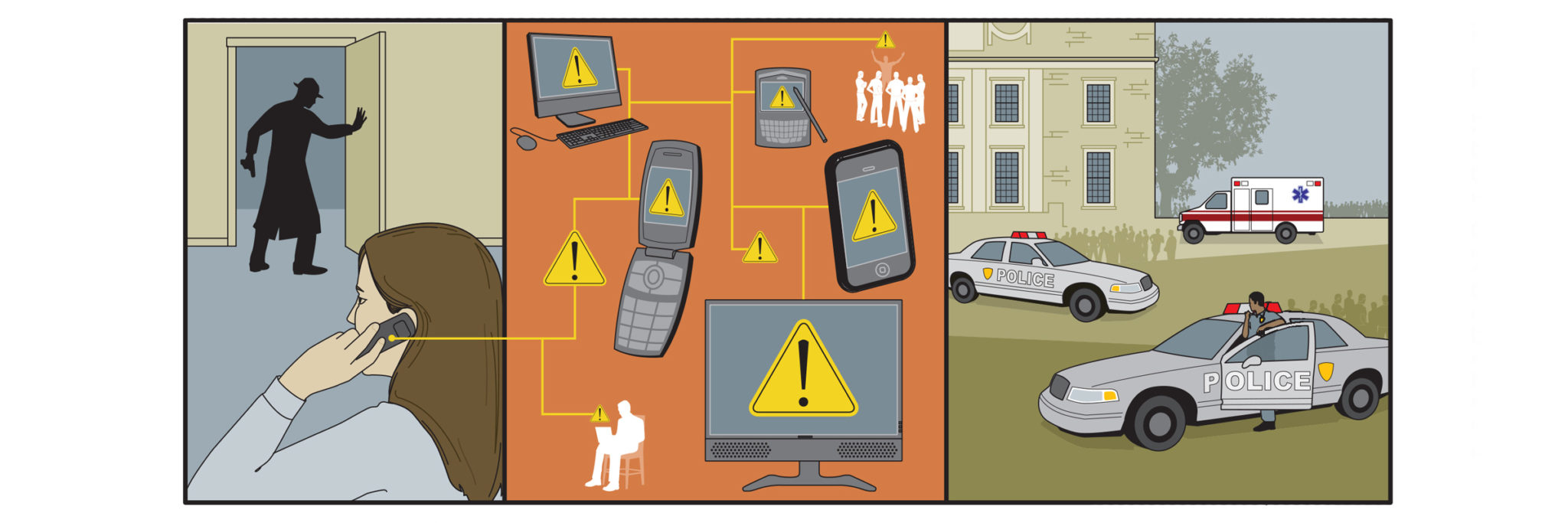It’s too awful to imagine. A person with a gun takes over the library. Our library. The crack of gunfire shatters Doane’s stately calm and reverberates across Denison’s campus. Screams follow. Or sick silence. Maybe there are hostages. Maybe people are seriously injured, or worse. Confusion turns to shock; fear becomes panic. They need help now. And the rest of campus needs to know what to do now.
Why even think such a thing? Because prevention and readiness are the key components of security. Right now, Denison’s Office of Security and Risk Management is making elaborate plans for an “active shooter” practice scenario, tentatively scheduled to take place in Doane Library during spring break. In addition to college staff, invited participants will include first-responders from the local police and fire departments, along with county and state emergency-management officials, the sheriff’s office, hospitals, and med-flight helicopter personnel.
“We prepare for the unimaginable,” says Garret Moore, director of security, safety and risk management. With his help, Denison runs through emergency response plans every year, including tabletop exercises, wherein responders from on campus and off gather to talk through all sorts of “what ifs.” What if avian flu breaks out on campus? What if a student is gravely injured? What if there’s an explosion?
Every sort of emergency is considered in crisis planning, including alcohol-related issues, like drunk driving and over-consumption; pedestrian safety; and, because of Denison’s geographic location, tornadoes. Fire, though, is at the top of the list. Moore says it’s the biggest potential risk on any college campus. Students make bad decisions sometimes—whether it’s drinking, smoking, or disabling smoke detectors in their rooms. To help combat the potential effects of those decisions, Denison continually retrofits its residence halls with sprinklers. This summer, it was Shorney’s turn, bringing the total number of “sprinklered” beds to 75 percent.
Every year during August orientation, first-year students are put through their paces. The Granville Township Fire Department provides lectures, tips, and advice. Outside in a parking lot, a firefighter shows students how to use a fire extinguisher. Pull the pin, aim the nozzle at the base of the fire, squeeze the operating lever, and sweep the nozzle from side to side. Powder whooshes onto the pavement as students line up to try it for themselves. Elsewhere, student-staff members, like RAs, are taught how to effectively evacuate buildings and count heads to make sure everyone’s safe. And after filling one of the Burton D. Morgan Center’s rooms with dense, white simulated smoke, first-year students are asked to crawl blindly on their hands and knees along the walls of the room to experience what it would be like to find an exit.
Efforts like these are indicative of Denison’s proactive stance on emergency management. More than a decade before the April 2007 shootings at Virginia Polytechnic Institute gave the world a tragic reason to take another look at campus safety, Denison had formal crisis management plans in place. But in the time since Virginia Tech’s tragedy, it has become apparent that there isn’t one perfect way to contact every person on a college campus. So best practices have come to include multi-tiered campus notification systems.
DU’s Emergency Alert Service includes a sophisticated text- and voice-messaging system from ConnectEd, which, in times of crisis, would deliver emergency alerts to cell phones and e-mail accounts. Messages also would pop up on every television screen on campus and on every computer that is signed-in to the network. Voice mail messages would be recorded on office landlines. And some low-tech but highly useful systems would kick in, like the campus phone tree, which starts with the campus operator calling 10 key people, who then contact another 10 people, and so on, like a lifesaving virus.

